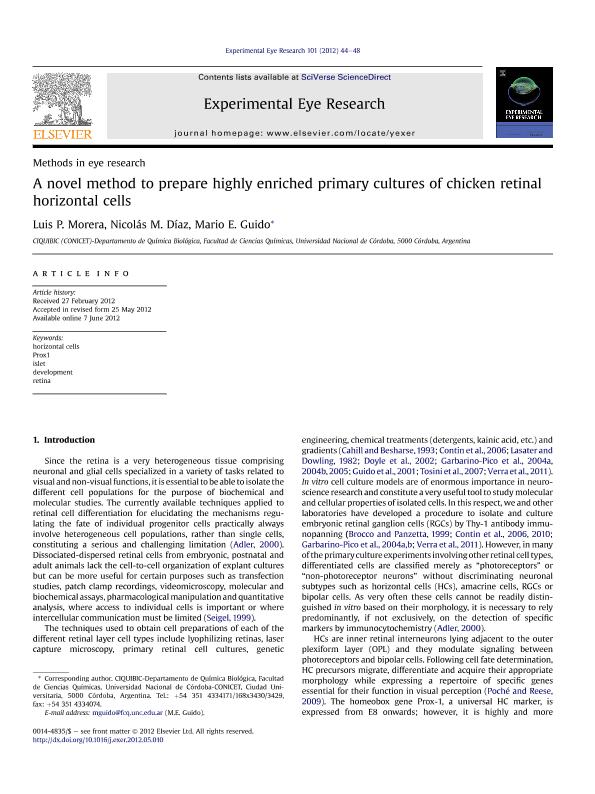Mostrar el registro sencillo del ítem
dc.contributor.author
Morera, Luis Pedro

dc.contributor.author
Díaz, Nicolás Maximiliano

dc.contributor.author
Guido, Mario Eduardo

dc.date.available
2023-05-15T16:54:48Z
dc.date.issued
2012-08
dc.identifier.citation
Morera, Luis Pedro; Díaz, Nicolás Maximiliano; Guido, Mario Eduardo; A novel method to prepare highly enriched primary cultures of chicken retinal horizontal cells; Academic Press Ltd - Elsevier Science Ltd; Experimental Eye Research; 101; 8-2012; 44-48
dc.identifier.issn
0014-4835
dc.identifier.uri
http://hdl.handle.net/11336/197567
dc.description.abstract
The retina is a heterogeneous tissue composed of different neuronal cells (photoreceptor (PRC), horizontal (HC), amacrine, bipolar and retinal ganglion RGC cells) and glial cells. Our aim in this work was to purify HCs from the chicken embryonic retina to obtain primary cultures highly enriched in these cells for further characterization. To this end, disaggregated retinas of chicken embryos at day 15 were subjected to a discontinuous bovine serum albumin (BSA) gradient of concentrations raging from 1 to 4%. After centrifugation, cells collected from the different phases were cultured for 4 days and characterized by immunochemistry and cell morphology. Phases were examined with specific antibodies against HC markers such as PROX-1, Islet-1 and calretinin, together with markers for other retinal cell populations. The results show that only in the fraction corresponding to 2.5% BSA did most of the cells display PROX-1 and Islet-1 positive immunoreactivities with a typical HC morphology. Moreover, Western blot assays indicate that the 2.5 % BSA phase exhibits the strongest PROX-1 immunolabeling, denoting the typical molecular weight (MW) of ~ 83KDa. Based on an accurate morphological analysis, a number of cells in this fraction resembled H1- and H3-type HCs (axon-bearing "brush-shaped" and axon-less "candelabrum-shaped" HCs respectively). In conclusion, the BSA gradient has so far proved to be a simple yet very useful method to selectively separate specific retinal cell types for the further study and characterization of their molecular, biochemical and electrophysiological properties.
dc.format
application/pdf
dc.language.iso
eng
dc.publisher
Academic Press Ltd - Elsevier Science Ltd

dc.rights
info:eu-repo/semantics/openAccess
dc.rights.uri
https://creativecommons.org/licenses/by-nc-nd/2.5/ar/
dc.subject
DEVELOPMENT
dc.subject
HORIZONTAL CELLS
dc.subject
ISLET
dc.subject
PROX1
dc.subject
RETINA
dc.subject.classification
Bioquímica y Biología Molecular

dc.subject.classification
Ciencias Biológicas

dc.subject.classification
CIENCIAS NATURALES Y EXACTAS

dc.title
A novel method to prepare highly enriched primary cultures of chicken retinal horizontal cells
dc.type
info:eu-repo/semantics/article
dc.type
info:ar-repo/semantics/artículo
dc.type
info:eu-repo/semantics/publishedVersion
dc.date.updated
2023-05-12T10:20:04Z
dc.journal.volume
101
dc.journal.pagination
44-48
dc.journal.pais
Países Bajos

dc.journal.ciudad
Amsterdam
dc.description.fil
Fil: Morera, Luis Pedro. Universidad Empresarial Siglo XXI. Vicerrectorado de Innovación e Investigación. Instituto de Organizaciones Saludables; Argentina. Consejo Nacional de Investigaciones Científicas y Técnicas; Argentina
dc.description.fil
Fil: Díaz, Nicolás Maximiliano. Consejo Nacional de Investigaciones Científicas y Técnicas. Centro Científico Tecnológico Conicet - Córdoba. Centro de Investigaciones en Química Biológica de Córdoba. Universidad Nacional de Córdoba. Facultad de Ciencias Químicas. Centro de Investigaciones en Química Biológica de Córdoba; Argentina
dc.description.fil
Fil: Guido, Mario Eduardo. Consejo Nacional de Investigaciones Científicas y Técnicas. Centro Científico Tecnológico Conicet - Córdoba. Centro de Investigaciones en Química Biológica de Córdoba. Universidad Nacional de Córdoba. Facultad de Ciencias Químicas. Centro de Investigaciones en Química Biológica de Córdoba; Argentina
dc.journal.title
Experimental Eye Research

dc.relation.alternativeid
info:eu-repo/semantics/altIdentifier/doi/http://dx.doi.org/10.1016/j.exer.2012.05.010
dc.relation.alternativeid
info:eu-repo/semantics/altIdentifier/url/https://www.sciencedirect.com/science/article/pii/S001448351200156X
Archivos asociados
